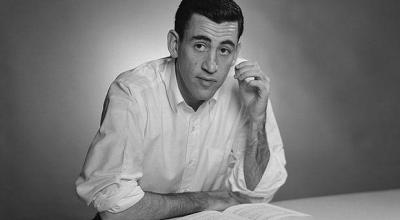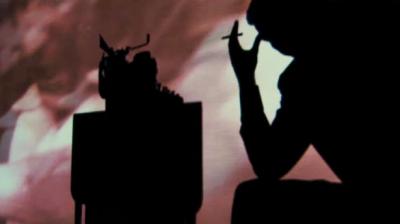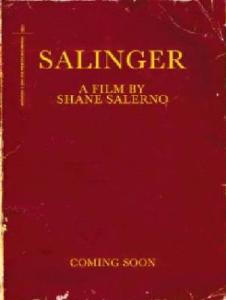By: debbie lynn elias
Who hasn’t read “Catcher In The Rye”? Who in their youth (or even in the maturity of life) didn’t feel a connection with Holden Caulfield and by extension, his creator/ alter ego, J.D. Salinger? Who wasn’t, at some point, swept into the mystery of the oft-described recluse who is Salinger, either during his life or on his death in 2010? Let’s face it, J.D. Salinger is a part of the global collective consciousness. And now, over eight years in the making, writer/director Shane Salerno (Armageddon, Alien vs. Predator) brings us SALINGER, a documentary designed to titillate and scintillate with “never before seen images” and facts about the man.

While there is nothing salacious, earth-shattering or shocking revealed during the documentary’s 120+ minutes (but for perhaps Sylvia, Salinger’s first wife and a known Nazi), what Salerno does deliver is a sometimes insightful historical piece that although at times ambiguous and disjointed, is more telling about the jealousy, self-aggrandizement and too rare touching, wistful longings, of its various interview subjects, as opposed to revelations about Salinger himself.
Vacillating back and forth through time with manipulative jump cuts, through interviews and documented evidence, Salerno mostly reiterates what we already know about SALINGER. His privileged upbringing, his WWII service, his PTSD and resulting nervous breakdown, his refusal to have his books or short stories made into films (after one not so pleasant experience with Samuel Goldwyn, mind you), his move to Cornish, New Hampshire where he lived out the last 50 years of his life, the disgruntled daughter who has already written a less than kind biography, the broken heart thanks to Oona O’Neill, and his desire for anonymity. Some surprises, however, lie within commentary about his attraction to young girls and the insight into his time during the war, from D-Day to VE-Day and thereafter in the intelligence theater, the latter of which clearly shaped SALINGER’s world and his writing.

Where Salerno excels with his storytelling is through editing segments with some extremely touching and revealing interviews. Perhaps the most telling is that of Jean Miller, who at age 14 first met Salinger while vacationing in Daytona Beach, struck up a friendship with years of correspondence between the two, and then when she was 20 years old, initiated love-struck sex, only to lose her friendship. Loving respectful memories also come from a 65-year friend of Salinger’s, his former Army comrade who served with him from basic training to D-Day and into the post-war era performing intelligence. His insight into the mindset and horrors of what these men endured and survived is unfathomable and unshakeable, and like Miller’s memories, are more telling about who J.D. SALINGER was than anything else elicited in the documentary.
Heartbreaking and poignant, Miller’s personal touch and that of Sgt. Roderick outshines the commentary by talking head biographers like Paul Alexander who exude pompous airs speaking about a man they never knew but on whom they try to arm-chair analyze. Problematic are title cards identifying some of the interviewees as “Friend” of SALINGER, especially when we learn that Salinger wrote them off 50+ years ago because of an argument and never spoke to them again. Disgruntling is the time spent interviewing an aged rapid fan/wannabe writer who talks about what we would today call “the stalking” of Salinger. What will resonate for today’s culture, however, is observant thoughtful reflection by Martin Sheen and an endearing snippet of John Cusack, the Lloyd Dobbler embodiment of youth, talking about carrying around a copy of “Catcher” in his pocket in his own youth. Charming touches.
Thanks to an extreme brevity of photographs of Salinger post-1965, Salerno rehashes the same few at every opportunity while inserting some smoke-and-mirror dramatic re-enactments of a dark-haired man at a typewriter or pacing in a room.

While Salerno goes to great lengths to further the mystery of SALINGER, even equating him to Howard Hughes, noticeably absent are mention of Salinger’s lawsuits and legal wranglings over the years – especially overseas – with books, unauthorized “sequels”, use of character names, etc. – which in and of itself tells much about how protective he was of his work and the perception of it, and how controlling he was. These cinematic omissions also speak volumes as to how much of a recluse Salinger was NOT. He was very in tune with everything. He designed his own mystique; one of the greatest self-generated PR manipulations of the century. Yet, Salerno avoids addressing these facts in SALINGER. He also similarly omits any direct statements or quotations from Salinger himself or his writings. To fill in these gaps and others, one may want to consider reading the companion biography book by Salerno and co-author David Shields which also heralds some fun revelations, among them, that SALINGER had only one testicle. Much more comprehensive than the film itself, the biography calls on over 200 interviews, more than 100 photos and access to never before seen diaries, letters and legal records, creating a truly definitive and fascinating portrait of this American legend.

Whether or not the SALINGER post-script comes to fruition remains to be seen. Are there countless works waiting for publication through a trust set up to administer copyrights for all of his existing works and oversee publication of those previously unpublished, among them, a romance novel, a novel based on his days in post-war intelligence, a Caulfield history and a Glass family history? If information is correct, we’ll find out between 2015 and 2020.
Despite its shortcomings, SALINGER is not only interesting, but enlightening for those unfamiliar with this voice of a generation. And it helps us to understand; understand why this man who intimately understood people, walked away from them for 50 years.
Directed by Shane Salerno












